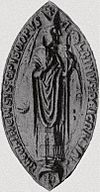Portal:Catholic Church
Introduction The Catholic Church, also known as the Roman Catholic Church, is the largest Christian church, with 1.28 to 1.39 billion baptized Catholics worldwide as of 2024. It is among the world's oldest and largest international institutions, and has played a prominent role in the history and development of Western civilization. The church consists of 24 sui iuris churches, including the Latin Church and 23 Eastern Catholic Churches, which comprise almost 3,500 dioceses and eparchies located around the world. The pope, who is the bishop of Rome, is the chief pastor of the church. The Diocese of Rome, known as the Holy See, is the central governing authority of the church. The administrative body of the Holy See, the Roman Curia, has its principal offices in Vatican City, a small independent city-state and enclave within the Italian capital city of Rome, of which the pope is head of state. The core beliefs of Catholicism are found in the Nicene Creed. The Catholic Church teaches that it is the one, holy, catholic and apostolic church founded by Jesus Christ in his Great Commission, that its bishops are the successors of Christ's apostles, and that the pope is the successor to Saint Peter, upon whom primacy was conferred by Jesus Christ. It maintains that it practises the original Christian faith taught by the apostles, preserving the faith infallibly through scripture and sacred tradition as authentically interpreted through the magisterium of the church. The Roman Rite and others of the Latin Church, the Eastern Catholic liturgies, and institutes such as mendicant orders, enclosed monastic orders and third orders reflect a variety of theological and spiritual emphases in the church. Of its seven sacraments, the Eucharist is the principal one, celebrated liturgically in the Mass. The church teaches that through consecration by a priest, the sacrificial bread and wine become the body and blood of Christ. The Virgin Mary is venerated as the Perpetual Virgin, Mother of God, and Queen of Heaven; she is honoured in dogmas and devotions. Catholic social teaching emphasizes voluntary support for the sick, the poor, and the afflicted through the corporal and spiritual works of mercy. The Catholic Church operates tens of thousands of Catholic schools, universities and colleges, hospitals, and orphanages around the world, and is the largest non-government provider of education and health care in the world. Among its other social services are numerous charitable and humanitarian organizations. (Full article...) Selected article
 Opus Dei, formally known as The Prelature of the Holy Cross and Opus Dei, is an organization of the Catholic Church that teaches the Catholic belief that everyone is called to holiness and that ordinary life is a path to sanctity. The majority of its membership are lay people, with secular priests under the governance of a prelate appointed by the Pope. Founded in Spain in 1928 by the Roman Catholic priest Josemaría Escrivá, Opus Dei was given final approval in 1950 by Pope Pius XII. In 1982, the Catholic Church made it into a personal prelature — its bishop's jurisdiction covers the persons in Opus Dei, wherever they are. The Prelature of Opus Dei has about 87,000 members in more than 80 different countries. About 70% of Opus Dei members live in their private homes, leading traditional Catholic family lives with secular careers, while the other 30% are celibate, of whom the majority live in Opus Dei centers. Opus Dei organizes training in Catholic spirituality applied to daily life. Aside from personal charity and social work, Opus Dei members are involved in running universities, university residences, schools, publishing houses, and technical and agricultural training centers.
Selected image
 Credit: Stevenj Joan of Arc, or Jeanne d'Arc in French ,(c. 1412 – May 30, 1431) was a 15th century national heroine of France. She was tried and executed for heresy when she was only 19 years old. The judgment was broken by the Pope and she was declared innocent and a martyr 24 years later. She was beatified in 1909 and canonized as a saint in 1920. Selected biography
 Albin (or Albinus) (d. 1269) was a 13th-century prelate of the Kingdom of Scotland. A university graduate, Albin is known for his ecclesiastical career in the diocese of Brechin, centred on Angus in east-central Scotland. Almost certainly a native of Angus, he appears to be a descendant of David of Scotland, Earl of Huntingdon, brother of King William I of Scotland, through an illegitimate son whom Earl David settled in the area around Brechin. Albin, himself an illegitimate child, made his career as a churchman in the local diocese, and served for some time as precentor of Brechin Cathedral before, in 1246, being elected Bishop of Brechin. He remained Bishop of Brechin until his death in 1269. Albin became Bishop of Brechin following an election and then a successful appeal for confirmation to the papacy. Pope Innocent IV's mandate for confirmation gave the details of the election.
Did you know...
Related portalsFeast Day of July 1
Serra was beatified by Pope John Paul II on 25 September 1988 in Vatican City. Amid denunciations from Native American tribes who accused Serra of presiding over a brutal colonial subjugation, Pope Francis canonized Serra on 23 September 2015 at the Basilica of the National Shrine of the Immaculate Conception in Washington, D.C., during his first visit to the United States. Serra's missionary efforts earned him the title of "Apostle of California". (Full article...)
Selected quote
News
SubcategoriesTopics
The Holy Bible:
Particular Churches (grouped by liturgical rite):
Things you can do
External resourcesWikiProjectsAssociated WikimediaThe following Wikimedia Foundation sister projects provide more on this subject:
Discover Wikipedia using portals |


































